A Time of Transition and Change: 1962-2018
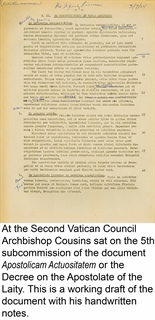 A new archbishop, William Edward Cousins (1902-1988) was appointed to Milwaukee in December 1958. Cousins had served in the Archdiocese of Chicago
A new archbishop, William Edward Cousins (1902-1988) was appointed to Milwaukee in December 1958. Cousins had served in the Archdiocese of Chicago  where he had served as a parish priest and then the head of the “Mission Band”—a group of traveling preachers who gave parish missions (retreats) throughout the archdiocese. A gifted preacher and a popular priest, he had become an auxiliary bishop of Chicago (1949) and was transferred to Peoria (1952-1958). He came to Milwaukee in January 1959, at almost exactly the same time as the recently-elected St. John XXIII had called for an ecumenical council. Cousins would attend all four sessions of the council. Vatican II would transform the Archdiocese of Milwaukee in significant ways.
where he had served as a parish priest and then the head of the “Mission Band”—a group of traveling preachers who gave parish missions (retreats) throughout the archdiocese. A gifted preacher and a popular priest, he had become an auxiliary bishop of Chicago (1949) and was transferred to Peoria (1952-1958). He came to Milwaukee in January 1959, at almost exactly the same time as the recently-elected St. John XXIII had called for an ecumenical council. Cousins would attend all four sessions of the council. Vatican II would transform the Archdiocese of Milwaukee in significant ways.
Council-inspired change was felt first in the archdiocese through the liturgy. The Mass was gradually translated into the vernacular. The altars of churches were turned around to face the people. New forms of celebrating the sacraments of penance and anointing of the sick were introduced. Liturgical efforts through music and various ministries sought to encourage “full, active, and conscious” participation by all in the Eucharistic celebration. Ecumenical efforts sought to forge ties with other religious communities, Christian and non-Christian, striving to find common ground and values.

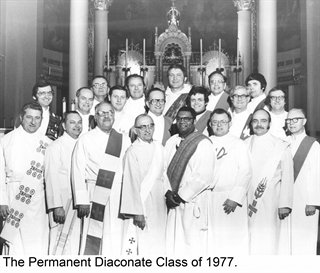 Education for the priesthood was changed in some important ways. St. Francis de Sales Seminary—from high school through theology underwent important changes in curriculum and preparation for the priesthood. The number of men entering the ministry began to drop sharply in the 1970s and 1980s. The high school and college seminary that had been built in 1963 was compelled to close in the 1980s due to shrinking enrollments. A significant number of men also resigned from the active ministry. Likewise the numbers of women religious began to decline as well. But there was a sharp up-turn in the numbers of lay persons interested in pastoral ministry. The Permanent Diaconate was restored and the first classes of deacons—who were permitted to be married—were ordained in the 1970s. St. Francis de Sales Seminary played an important role in the training and formation of a generation of these ministers.
Education for the priesthood was changed in some important ways. St. Francis de Sales Seminary—from high school through theology underwent important changes in curriculum and preparation for the priesthood. The number of men entering the ministry began to drop sharply in the 1970s and 1980s. The high school and college seminary that had been built in 1963 was compelled to close in the 1980s due to shrinking enrollments. A significant number of men also resigned from the active ministry. Likewise the numbers of women religious began to decline as well. But there was a sharp up-turn in the numbers of lay persons interested in pastoral ministry. The Permanent Diaconate was restored and the first classes of deacons—who were permitted to be married—were ordained in the 1970s. St. Francis de Sales Seminary played an important role in the training and formation of a generation of these ministers.
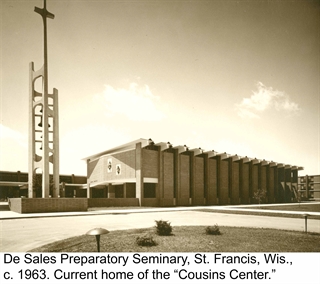 New approaches to catechetics, archdiocesan finances, and schools created new leadership posts in the archdiocese. Archbishop Cousins consecrated veteran
New approaches to catechetics, archdiocesan finances, and schools created new leadership posts in the archdiocese. Archbishop Cousins consecrated veteran  chancery hand and Chancellor, Monsignor Leo Brust as his auxiliary in 1969. The archbishop himself moved out of the old Pabst Mansion (1975) to suburban Brookfield. Diocesan offices were transferred to an unused school at St. Therese Parish on Bluemound Road. Later they would be relocated to the buildings of the former minor and college seminaries and re-christened the “Cousins Center.”
chancery hand and Chancellor, Monsignor Leo Brust as his auxiliary in 1969. The archbishop himself moved out of the old Pabst Mansion (1975) to suburban Brookfield. Diocesan offices were transferred to an unused school at St. Therese Parish on Bluemound Road. Later they would be relocated to the buildings of the former minor and college seminaries and re-christened the “Cousins Center.”
Vatican II provided a spring board for a renewed interest in social action on the part of priests, religious, and laity. Taking seriously the council’s demand to “read the signs of the times”; the local Catholic Church became very deeply involved in issues of racial justice. Father James Groppi, a priest of the archdiocese, would become a nationally recognized leader in the quest for open housing. Beginning in August 1967 and going for nearly a year, he led Open Housing Marches down the 16th Street Viaduct in Milwaukee. Not everyone agreed with Groppi or approved of his methods. It was a time of polarization in the local church as Archbishop Cousins received a great deal of pressure from all sides to take a firmer stand for or against Groppi.

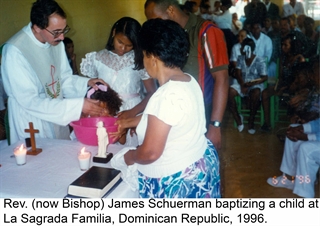 Milwaukee Catholics also looked outward to mission fields. In the 1960s, the archdiocese began a mission in Paraguay. This eventually folded, but later the archdiocese would take on La Sagrada Familia parish in the Dominican Republic. A diocesan-based religious association, the Community of St. Paul, staff this outpost.
Milwaukee Catholics also looked outward to mission fields. In the 1960s, the archdiocese began a mission in Paraguay. This eventually folded, but later the archdiocese would take on La Sagrada Familia parish in the Dominican Republic. A diocesan-based religious association, the Community of St. Paul, staff this outpost.
At home, the steady growth of the state’s Latino/a population created a more visible presence for this community which had been present in the archdiocese for many decades. Ministry to migrant workers and outreach to archdiocesan Latinos became a more pressing archdiocesan concern in the 1960s. Latino/a Catholic numbers grew in Milwaukee and virtually every other city of the archdiocese. Ministry to the Spanish-speaking became an archdiocesan priority.
Catholic schools, which reached their peak enrollment in the mid-1960s, began a precipitous plunge in enrollment through the remainder of the decade and into the 1970s. Religious sisters, with declining memberships and changes in their placement policies, could no longer operate these schools. The expense of these schools, aggravated by their declining enrollments, often taxed the finances of parishes. Many schools, elementary, high schools, and even one college (Dominican of Racine), closed their doors.
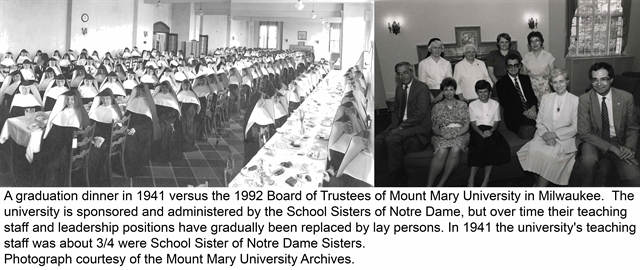


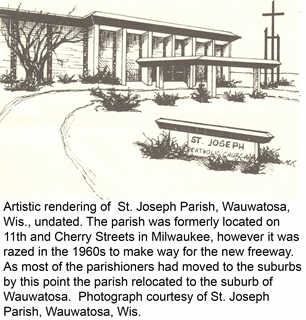 Parish memberships in the older urban parishes also took a down-turn. Venerable old churches like St. Leo’s, St. Gall, St. Boniface, and St. Ann’s all had shrinking memberships. Suburban parishes grew rapidly in places like Mequon, Brookfield, and New Berlin. Older ethnic churches in Racine, Kenosha, Beaver Dam, Sheboygan, and Fond du Lac held firm for a time, but by the 1990s, parish closings and consolidations began to take place.
Parish memberships in the older urban parishes also took a down-turn. Venerable old churches like St. Leo’s, St. Gall, St. Boniface, and St. Ann’s all had shrinking memberships. Suburban parishes grew rapidly in places like Mequon, Brookfield, and New Berlin. Older ethnic churches in Racine, Kenosha, Beaver Dam, Sheboygan, and Fond du Lac held firm for a time, but by the 1990s, parish closings and consolidations began to take place.
The archdiocese had a strong network of Catholic colleges and universities sponsored by religious communities. As time went on, these institutions reorganized their leadership structures and began to turn over more administrative control to lay persons. Likewise, the strong etwork of Catholic hospitals responded to the changing demands of medical technology and health care structure. Hospitals became part of “health care systems” which managed hospitals and clinics.
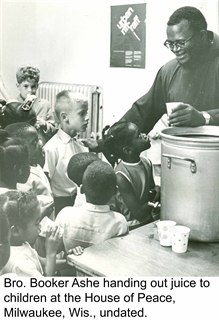 Church leaders, however, never abandoned the city altogether. The Capuchin Friars continued to serve in the
Church leaders, however, never abandoned the city altogether. The Capuchin Friars continued to serve in the  cities, welcoming African American parishioners and providing for the spiritual and social needs of their neighborhoods. Brother Booker Ashe, OFM, Cap. and Father Matthew Gottschalk, OFM. Cap. founded the House of Peace (1968) a Capuchin ministry that offered social services and spiritual support to all who came to its doors.
cities, welcoming African American parishioners and providing for the spiritual and social needs of their neighborhoods. Brother Booker Ashe, OFM, Cap. and Father Matthew Gottschalk, OFM. Cap. founded the House of Peace (1968) a Capuchin ministry that offered social services and spiritual support to all who came to its doors.
Cousins retired as archbishop in 1977 and was replaced by the Abbot Primate of the Benedictines, Rembert G. Weakland, OSB (1927-). Weakland, a native of Pennsylvania, had formerly been the Archabbot of St. Vincent Monastery in Latrobe, Pennsylvania. He was a skilled musician, a capable administrator with international experience, and man very much in touch with the spirit and letter of Vatican II. He advanced the process of bringing the archdiocese more deeply into the spiritual and organizational renewal demanded by the Council. He pushed forward on consultative bodies, e.g. parish councils and the Archdiocesan Pastoral Council. One initiative in the early 1980s was the adaptation of a program from the Archdiocese of Newark called RENEW. Scripture study, small group sharing, and liturgical celebration were part of this endeavor which was received favorably by many in the archdiocese. Weakland also welcomed popular seminary scripture professor and rector, Richard J. Sklba as his auxiliary. Sklba was ordained in December 1979.

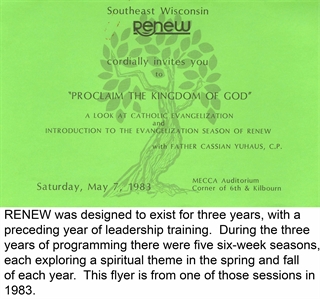 Weakland was often called upon by his fellow bishops to represent them at Synods in Rome. He also took the lead in producing a major pastoral letter on the Catholic response to the American economy. After many hearings, and several drafts, “Economic Justice for All” (1986) was the handiwork of the committee Weakland headed. This document was overwhelmingly approved by the US bishops.
Weakland was often called upon by his fellow bishops to represent them at Synods in Rome. He also took the lead in producing a major pastoral letter on the Catholic response to the American economy. After many hearings, and several drafts, “Economic Justice for All” (1986) was the handiwork of the committee Weakland headed. This document was overwhelmingly approved by the US bishops.
The mood in the church and the archdiocese shifted significantly with the advent of Pope St. John Paul II (1978-2005). Pope John Paul II traveled extensively around the world and several times to America. He inspired a generation of young men and women to embrace religious vocations.
In the 1990s, the scandal of clerical sexual abuse erupted in Milwaukee and around the nation. A number of cases were surfaced which eventually embroiled the archdiocese in litigation and bankruptcy.
Archbishop Weakland himself was caught in a web of scandal over the use of archdiocesan monies in 2002. He resigned and was swiftly replaced by Archbishop Timothy Dolan. Dolan, a church historian, had been the rector of the North American College in Rome and an auxiliary bishop in St. Louis. A genial and popular man, Dolan loved being with people, talking with them on the phone and appearing at local parish events. His short term in Milwaukee was ended when he was transferred to the Archdiocese of New York (2009) and was created a cardinal by Pope Benedict XVI. He was succeeded by Bishop Jerome E. Listecki of La Crosse.
Written by Rev. Steven M. Avella
Photographs and documents courtesy of the Archdiocese of Milwaukee Archives, unless otherwise noted. Photographs and documents cannot be reproduced without prior written authorization. For permission to reproduce contact the archdiocesan archives.